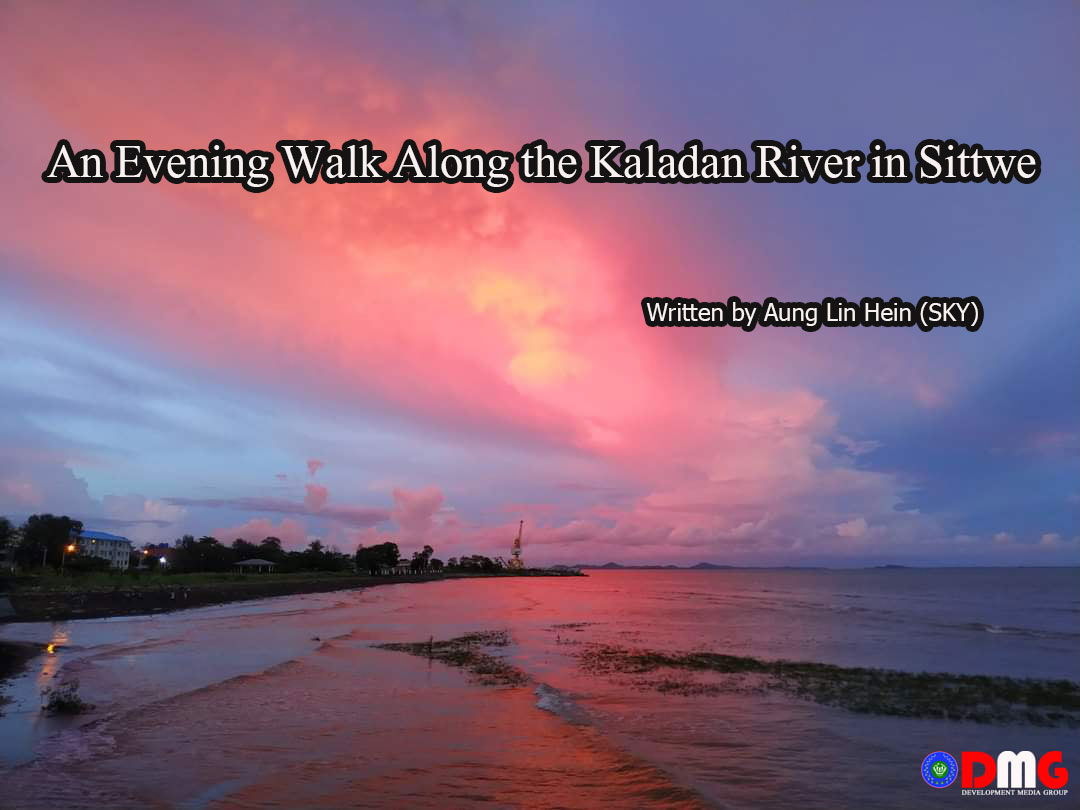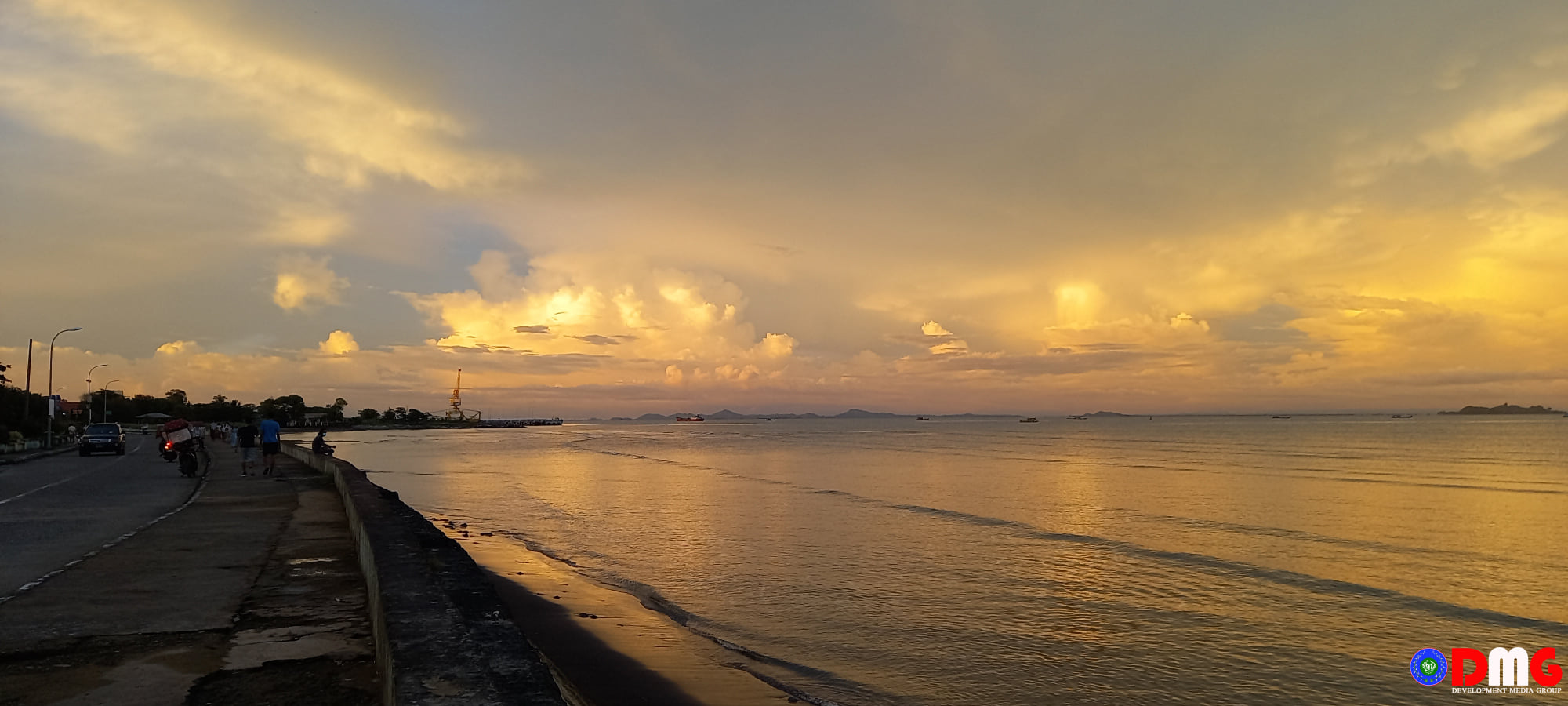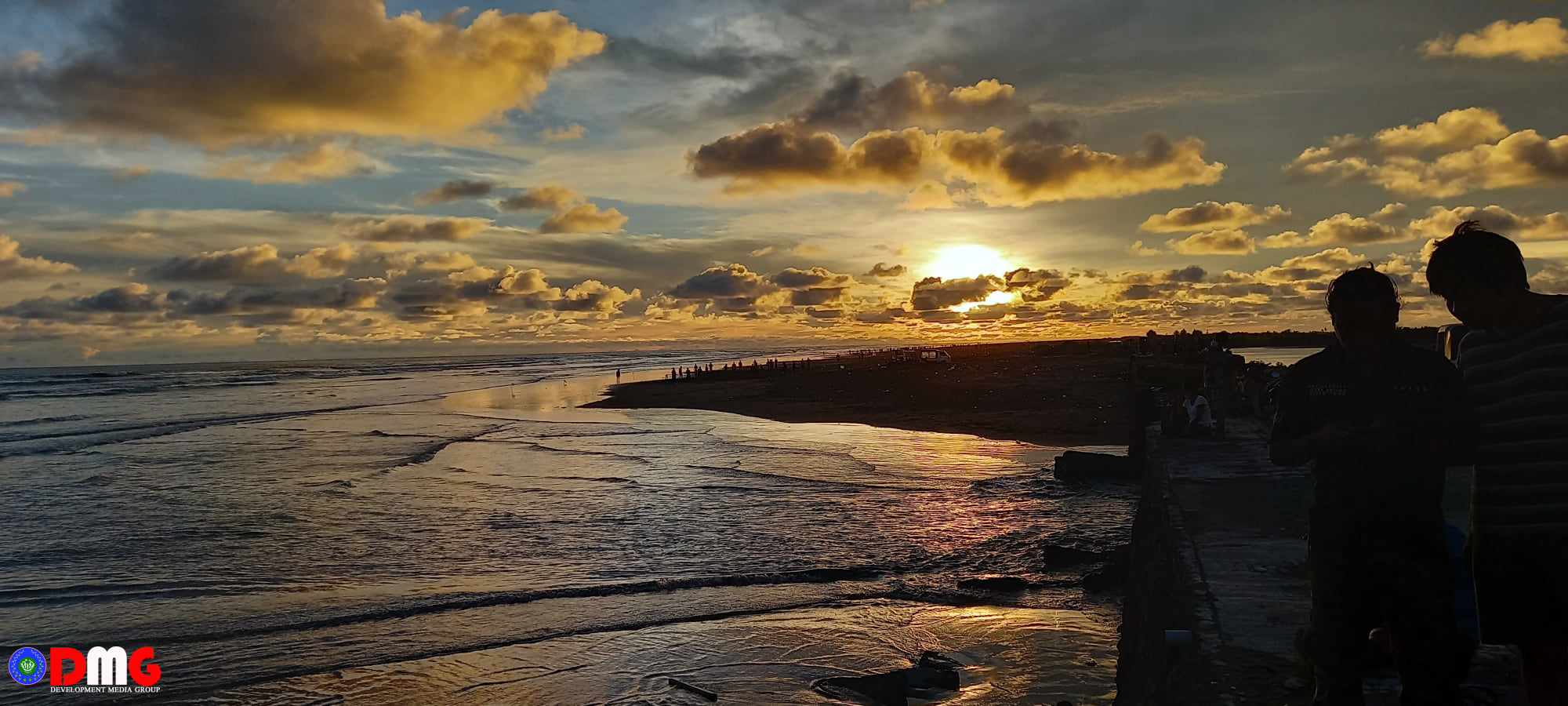- Weekly Highlights from Arakan State (Jan 12-18, 2026)
- Arakan Army denies junta claims of drug involvement
- Water shortages hit nearly 2,000 displaced people in Ponnagyun
- Junta airstrikes and naval shelling kill two displaced women in Kyaukphyu
- 7-year-old kidney patient in Kyauktaw seeks financial support for ongoing treatment
An Evening Walk Along the Kaladan River in Sittwe
A group of young people can be seen playing football in a field. It is gratifying to see so many young people competing so fiercely. Isn’t physical activity very important for health reasons? However, there are many elderly people sitting on the field’s sidelines, some wearing masks but others without masks. I wander off in front of an audience that could be infected.
15 Sep 2021

Written by Aung Lin Hein (SKY)
These days, the rainfall has decreased. Despite all the good rains that came after late summer, rainfall totals have dropped significantly in September.
As the southwest monsoon draws near, the colourful evening paintings on the banks of the Kaladan River come to life in anticipation of autumn.
We have had a tiring year and more. As the spring passed in 2020, the Covid-19 plague struck. In July and August of this year, a third wave of Covid-19 further stirred up the political tumult and economic turmoil of the times. It was a nightmare that claimed many lives and threatened the minds and bodies of many people.
If the value of love is better understood during these crises, it will be profitable. Now it’s just as if we were lucky enough to meet again at the end of a war.
Those who had the opportunity to reimagine the colourful evenings of September were, in other words, those who survived the third wave of Covid-19. For almost two months, he or she marched to the banks of the Kaladan River for a way out of the house. The sky is beautiful every evening. The sunsets are like a painting, especially on the banks of a river. I walked near the housing project where I saw the signs of change.
The image of Katkyaw Yanpyay Mahnpyay being built by the world missionary Adeikhtan Sayadaw was gradually transformed into a pagoda. By the end of the monsoon, construction seems to be accelerating. Once the pagoda is built and worshipped, these places, which are known as the Kassapa area, are expected to be even more prosperous. But for the grassroots, the real estate market is far from ideal when it is not imaginary. The real estate market in Sittwe is an example for tales of 1,001 nights.
As the sun sets, the sky changes colour. Occasionally there is a variation in the colour of the watermelon, sometimes from the colour of shrimp to the color of saffron. I was reminded of the poem Cloud Zoo, which I taught in high school English. Clouds are allowed to see freely. The colour-changing clouds are very natural with a variety of evening colours. Under the only unchanging concept of change in the whole world, I wondered if the movement of the clouds was a sign of volition.
At one point, a rainbow fell directly on the banks of the Kaladan River. I stared at the colourful rainbow and saw another light rainbow. We are witnessing the wonders of nature. There is no reason why any taxpayer should dislike the beautiful scenery of inexpensive natural scenery. It would be nice if nature could provide a momentary relief for the grassroots, who could not afford land like that of New York or Singapore.
A group of young people can be seen playing football in a field. It is gratifying to see so many young people competing so fiercely. Isn’t physical activity very important for health reasons? However, there are many elderly people sitting on the field’s sidelines, some wearing masks but others without masks. I wander off in front of an audience that could be infected.

In fact, the unfinished Covid-19 pandemic cannot be ignored even if the number of cases is reduced. In addition to being careful, we have to adhere to the virus-related regulations. But I have never blamed the scene of young people playing football. At the same time, I saw people looking for food because they could not open shops along Strand Road for two months. I do not know if there will be time for them to experience whether nature is beautiful or mysterious. I think they are still praying that sales are down because of the late rainy season.
There will inevitably be images common to anyone walking along Strand Road. People who walk along Strand Road can see a group of adults discussing politics; young people playing guitar; children exercising; children running aimlessly; cyclists; people flying kites; readers; drinkers; shopkeepers; and fishermen. I imagined it would be better to see people playing violin, music concerts along the river, with graffiti artists, poets, natural food vendors, and gardeners planting flowers.
However, everyone who walks along the beach for a breathtaking view of the river will surely love the river and its natural breeze. Scenes of those who make up for the rest of the day can be seen on any beach in the world. But as unpleasant as the city and the river are, the unruly dumping of rubbish is still rampant, and bad people are still in control. Depending on the nature of the river, some people who live in a beautiful, small town may be upset by the practice of throwing garbage into the river, and questions of allowing them to do so, or not.
No one truly has the right to appeal to a court for justice for a river. Unlike the river, the sea is clear. If someone comes and throws garbage, he or she will be sent back to shore with the help of the waves. The natural curvature of rivers is openness. It shows the sensation of the sun, but when the time is right, the wind can be very strong. But the river is not as proud as the sea.
I continued to walk along the Kaladan River. I saw a teenage couple taking a selfie. And I assume they posted the photo on social media. The scene of two lovers on the shore becomes more natural and beautiful at dusk. I suddenly remembered the lyrics of the song “Oh Kassapandi” sung by the vocalist Kaizar. Two couples have made a vow on the river bank. In this age of materialism and chaotic change, I would like to say that if the two lovers keep their promises, they will be considered the lucky ones in the world.
In any case, everyone who loves will love the nature and beauty of the Kasapandi River. Is the River Kassapandi a song for every lover or a poem of love that will flow forever? The breeze that blows across the river feels cool and refreshing when it touches the surface. From the top of the cliff, I breathed a sigh of relief on the other side of the river, inhaling real, organic oxygen that was hard to find in an emergency. I could see the Alae (middle) Phayonkar hills and Anauk (west) Phayonkar Hills.
Looking back, I could see the Bay of Bengal and the Lay Chin Taung lighthouse under the sun, just beyond Sittwe’s horizon. This small port city originally built by the colonial British was beautiful. I just want to wake up from the old, negative images with the opposite of beauty. Even though the old images of nearly a decade of bloody conflict and protests and struggles remain in the past, the search for a solution to peace and justice is still there. There are still some unfinished paintings.
The sound of a ripple stopped my expanding thoughts. There are many people who depend on the river for their livelihood. Cross-border cargo ships, birds, fishing boats and passenger yachts sway in the high tide. The colour of the river, which could indicate that it was raining heavily on the right side of the river, looked like a light cup of moonshine. Boats loaded with timber, bamboo and crops from the upper reaches of the Kaladan River enter the Sittwe market, and on the way back, those boats carry dried goods from the east of the Arakan (Rakhine) Yoma. The Kaladan River is ready for seagoing ships to shelter from the storm. This river would have been useful when the great powers came and traded during the heyday of the Mrauk-U period, more than 500 years ago.

During World War II, enemies and allies would have used the river and naval vessels. However, the former Mingyi Kyauktan (Rock-site) has disappeared and is no longer allowed to settle like the deep-sea port used by the Indian government. Every time I see an Indian deep-sea port, I miss the Mingyi Kyauktan. I remember the sharp thought of Sayadaw U Ottama throwing his prize as he did not win the first prize when he was young into the Kaladan River from Mingyi Kyauktan.
It is also a coincidence that every September there is a memorial service for the revolutionary leader Sayadaw U Ottama. An Indian deep-sea port that is not accessible to the locals is built on a location where Mingyi Kyauktan is located. It is also said to be a geographical intersection of political and economic strategies, with plans to export goods to Mizoram, India. Natural resources are the curse of medicine.
It would be more than insane to approach the shore like a rushing tidal wave again. The firmness and cohesiveness of the shoreline is often seen in waves. The river on the right side of the river was found to be freshwaters.
The Kaladan River’s headwaters can be found in Mizoram State of India, before winding through Chin State and Arakan State in western Myanmar. The Kaladan River is called the Chhimtuipui River in India. It flows through Mizoram, then the Chin Hills, passing through Paletwa, Kyauktaw, Ponnagyun, Pauktaw, and finally into the Bay of Bengal near Sittwe.
The Kaladan is an indispensable source of cultural diversity, as people from all walks of life — as well as wildlife and marine life — are found living along the river. But the river has not been the same after two years of war in Arakan and Chin states. An entire village along the river was engulfed in flames at one point, and the sound of small arms and heavy weapons could be heard along the banks of the Kaladan River at various points of time and space.
If all those who are victorious over natural resources are surveyed, will all those who see the beauty of nature feel it? Is it the law of the world to be absent in the wars of liberation for the enjoyment of nature and natural resources? The sun was setting while I was thinking that a river of such innate humanity and beauty might know these answers, but I did not.




.jpg)















